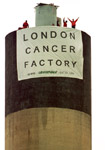
edmonton chimney
Heard before His Honour Judge Mervyn Roberts
Crown Prosecution Service: Mr Christopher Ball QC and Mr Morris
Defending: Mr Owen Davies QC and Ms Judy Khan
The cross-examination of Mr Rob Gueterbock, Greenpeace campaigner and defendant, continued. Mr Gueterbock explained that waste incineration had to be stopped before any sensible debate around the issue could take place. He pointed to the 'precautionary principle' and said that where there was evidence of cancers, birth defects and other negative health effects it was essential to act quickly and perhaps before all of the evidence could be collated.
Mr Gueterbock reiterated that in occupying the chimney at Edmonton Incinerator he had acted to protect life, health and property and that he had believed people living around Edmonton were in imminent danger. Mr Gueterbock said that the law was wrong in permitting the discharges at Edmonton and that Greenpeace had been morally right in taking action.
Mr Gueterbock was emphatic that the action at Edmonton was not a publicity stunt and that it was a legitimate attempt to "shut down a massive waste incinerator". Mr Gueterbock denied that he had taken the law into his own hands and repeated that he considered the occupation had been morally justified and believed his actions had directly contributed to an improvement in air quality around Edmonton for the period that the plant was shut.
The next witness for the defence was Mr Alan Watson, an environmental consultant and chartered engineer who had worked for the Department of the Environment for seven years and for Friends of the Earth as the senior industry advisor. Mr Watson had examined the public records of Edmonton Incinerator on behalf of Greenpeace and had made some observations on his findings in two reports.
Mr Watson described how the public record for the period 1996 to 2000 showed 20 exceedances of the legal emission limits for Edmonton whilst his own analysis had revealed at least 28 breaches. He also referred to an independent study of December 2000 by REC Ltd which showed that continuous monitoring of nitrogen oxides in one of the Edmonton flues revealed exceedances of the legal limit for 26 out of the 26 hours monitored. In the other flue the standard was breached in 25 hours out of the 26 hours monitored.
Mr Watson also disputed earlier assertions by Mr Montgomery of the Environment Agency that it was not possible to continuously monitor for dioxins. Mr Watson pointed out that a practical technique existed, approved as an equivalent to the US Environmental Protection Agency method, which continuously monitored dioxins and was a compulsory test for incinerators in Belgium. Mr Watson pointed out that this technique gave values for dioxin concentrations that were typically 30 to 50 times higher than detected by the snapshot method currently used by the Environment Agency.
The case continues.

